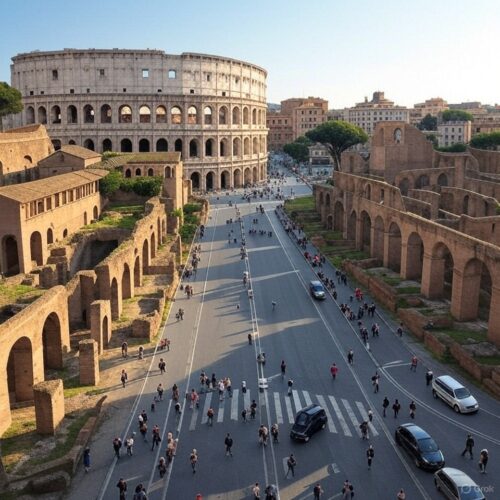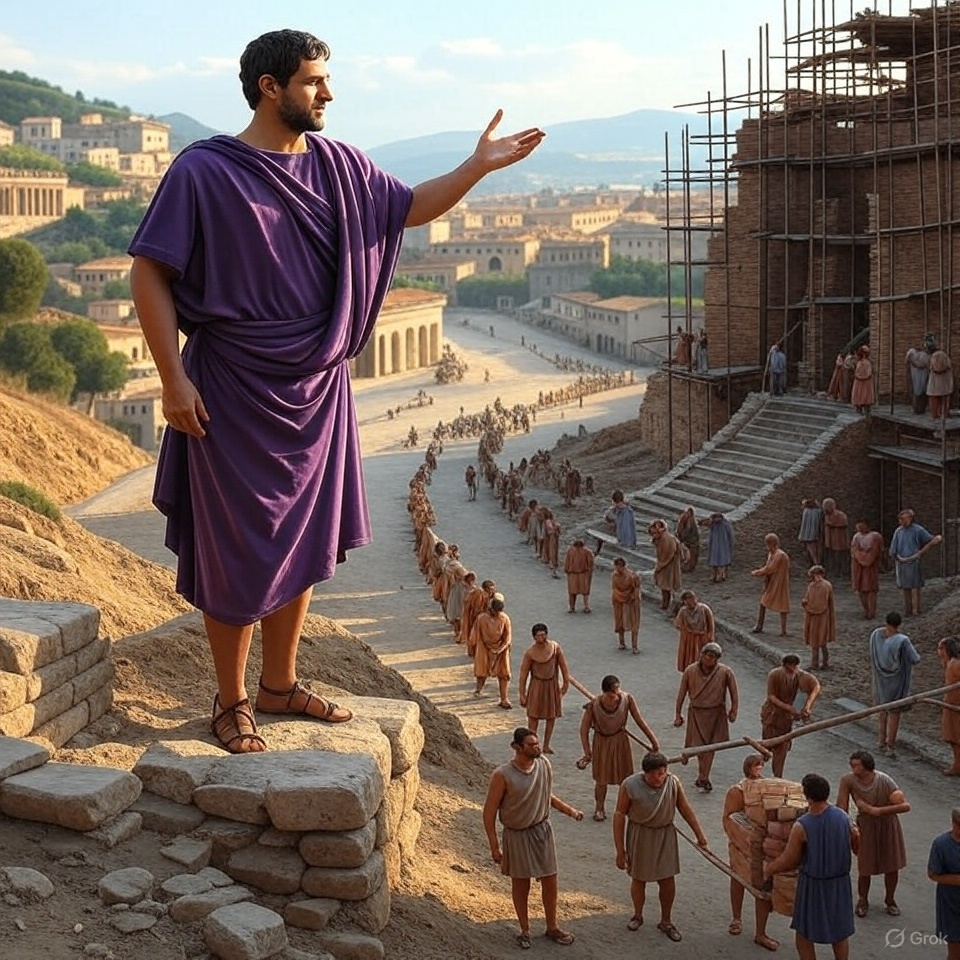### Introduction: A City in Flames, a Story for Today
Imagine a bustling city, the heart of an empire, suddenly engulfed in flames. On July 18, 64 AD, Rome—the eternal city—faced one of its darkest moments: the Great Fire. This wasn’t just a fire; it was a cataclysm that razed homes, temples, and lives, reshaping history in its smoky wake. For six relentless days, the blaze tore through the city, leaving behind ruins and a legacy that echoes through the centuries. But from those ashes rose a Rome reborn—stronger, smarter, and more united. In this blog, we’ll dive deep into the fiery chaos of July 18, 64 AD, uncover the gritty details of what happened, and explore how this ancient disaster holds powerful lessons for your life today. Get ready for a journey through history that’s as educational as it is inspiring—and yes, we’ll even make it fun along the way!
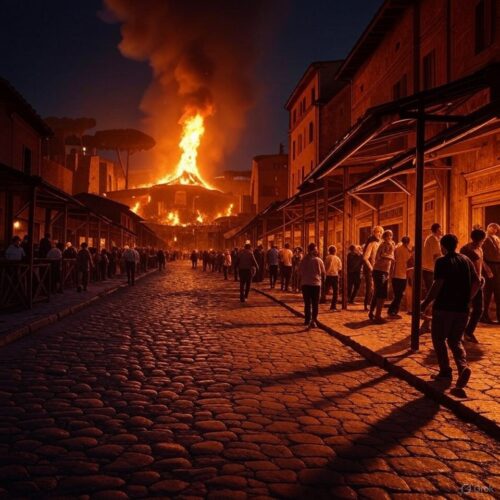
### The Great Fire of Rome: A Historical Inferno Unfolds
Let’s set the scene. Rome in 64 AD was a sprawling metropolis, the capital of an empire stretching from Britain to North Africa. Its population, likely nearing a million, lived in a chaotic mix of grand marble temples and rickety wooden tenements. The city was a tinderbox: narrow, winding streets packed with flammable buildings, many made of timber and topped with straw roofs. On the night of July 18, a spark—perhaps from a cooking fire, an oil lamp, or even a stray ember—ignited near the Circus Maximus, the massive chariot-racing stadium in the heart of the city.
The fire started small, licking at the shops and warehouses that lined the Circus. These were packed with goods—grain, oil, cloth—all perfect fuel. A dry summer breeze fanned the flames, and within hours, the blaze was out of control. The wooden structures caught like kindling, and the tight streets trapped the heat, turning Rome into an oven. The Roman firefighters, known as the *Vigiles*, sprang into action. These were no modern fire brigades; they were a mix of slaves and freedmen armed with buckets, axes, and primitive pumps. They fought valiantly, but the fire mocked their efforts, leaping from building to building.
By dawn on July 19, the scope of the disaster was clear. The fire had spread beyond the Circus Maximus, racing up the Palatine and Caelian Hills, two of Rome’s famous seven hills. Temples, homes, and public buildings crumbled. The *Forum Boarium*, a bustling cattle market, was reduced to ash. The *Temple of Vesta*, home to the sacred eternal flame of Rome, was threatened—ironic, given its symbolic role. For six days, the fire raged, its roar drowning out the cries of the displaced. Eyewitness accounts are scarce, but the historian Tacitus, writing decades later, described a city “overwhelmed by disaster,” with flames “sweeping through the level districts and climbing the hills.”
What caused it? That’s where the story gets juicy—and murky. The official line was an accident: a spark in a dry, crowded city. But rumors swirled like the smoke. Emperor Nero, the eccentric ruler of the day, became the prime suspect. Some whispered he’d ordered the fire to clear land for his dream project, the *Domus Aurea* (Golden House), a lavish palace complex he’d been itching to build. Others claimed he watched the fire from a tower, strumming his lyre and reciting poetry about the fall of Troy—a dramatic image, though likely exaggerated. Tacitus, ever the skeptic, noted that Nero was in Antium (modern Anzio), 35 miles away, when the fire began, only returning when it threatened his own palace. Still, the gossip stuck, and Nero’s reputation took a hit.
The fire’s toll was staggering. Of Rome’s 14 districts, three were completely destroyed, and seven were heavily damaged. Only four escaped unscathed. Historians estimate that up to two-thirds of the city—hundreds of acres—was reduced to rubble. The human cost is harder to pin down. Thousands likely perished, trapped in collapsing buildings or suffocated by smoke. Tens of thousands more were left homeless, their livelihoods gone. The economic ripple was immense: markets vanished, food supplies dwindled, and prices soared. Rome, the invincible, lay broken.
But the fire didn’t just destroy—it revealed. It exposed the city’s vulnerabilities: poor planning, flammable materials, and a lack of coordinated defenses. And it set the stage for what came next.
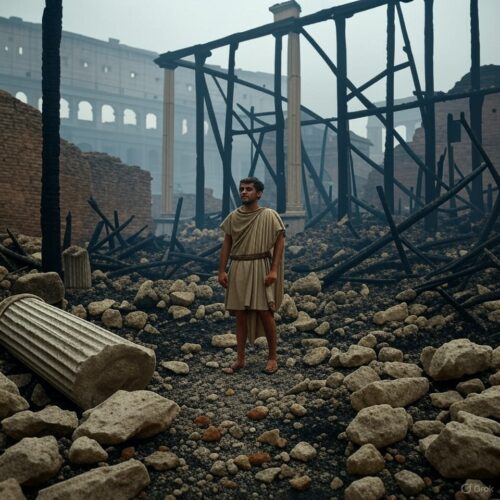
### The Aftermath: Nero’s Rebirth of Rome
Enter Nero, stage left—love him or hate him, he didn’t waste time. With the fire finally dying out after six days (a smaller flare-up on day nine was quickly quashed), he faced a city in chaos. His response was a mix of pragmatism, opportunism, and flair. First, he opened his palace gardens to the homeless, distributed food, and slashed grain prices to ease the suffering. Then, he got to work rebuilding—and here’s where the story takes a fascinating turn.
Nero didn’t just rebuild Rome; he reimagined it. The old city’s haphazard layout—narrow alleys, wooden slums—was scrapped. In its place, he ordered wide, straight streets lined with brick and stone buildings. Firebreaks—open spaces to halt a blaze’s spread—were carved out. Building codes tightened: no more towering tenements packed too close together. Roofs had to be fire-resistant, and porticoes (covered walkways) were added to shield streets from future flames. It was urban planning on a grand scale, born from disaster.
The centerpiece of Nero’s vision was the *Domus Aurea*. Spanning up to 300 acres across the Palatine and Esquiline Hills, this palace was a marvel—and a scandal. It featured a 120-foot bronze statue of Nero as the sun god, a man-made lake, vineyards, and rooms adorned with gold, ivory, and frescoes. One hall even had a rotating ceiling mimicking the stars. Critics howled that Nero was profiting from Rome’s misery, seizing burned-out land for his vanity project. Supporters argued it symbolized renewal. Either way, it was a bold statement: Rome would rise again, and Nero would lead the charge.
To fund this, Nero leaned on the empire’s provinces, hiking taxes and squeezing the elites. He also deflected blame. With rumors pinning the fire on him, he pointed the finger at a new scapegoat: Christians. This small, misunderstood sect was accused of arson and “hatred of mankind.” Nero staged gruesome executions—burning Christians alive as torches or feeding them to beasts in the arena. It was a brutal distraction, and it marked the start of Rome’s rocky relationship with Christianity.
The rebuilding took years, but the results were undeniable. By the late 60s AD, Rome was transformed. The new streets bustled with trade, the stone buildings gleamed, and the city felt safer, more orderly. The fire had been a brutal teacher, and Nero—whatever his motives—had learned its lessons. Rome’s population adapted too, rebuilding their lives with a mix of grit and ingenuity. The city’s spirit, though battered, endured.
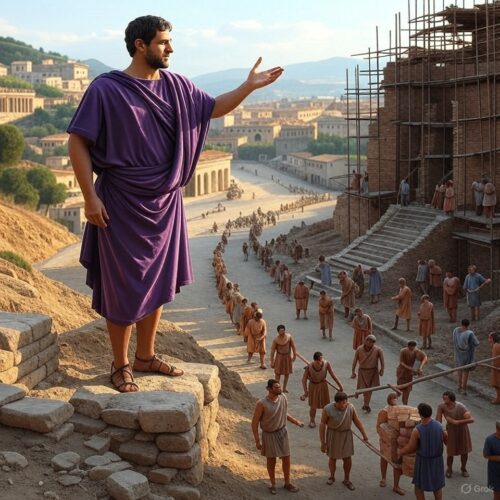
### Digging Deeper: The Fire’s Lasting Echoes
The Great Fire wasn’t just a one-off tragedy; it left ripples that shaped Rome for centuries. Let’s unpack some of the juicier details. First, the fire’s scale was unprecedented for its time. Tacitus claimed it outstripped even the sack of Rome by the Gauls in 390 BC—a bold comparison. The Circus Maximus, where it began, was a massive oval, 2,000 feet long, seating 250,000 spectators. Its wooden stands and surrounding shops were a perfect spark point, and the fire’s path—up the hills—followed the city’s natural contours, fueled by wind and density.
Nero’s urban reforms were revolutionary too. Before the fire, Rome had grown organically, a maze of streets dating back centuries. Post-fire, it began to resemble a planned city, a precursor to modern urban design. The use of brick and concrete—less glamorous than marble but far safer—became standard. Archaeologists later found traces of these changes: wider roads, thicker walls, and drainage systems improved under Nero’s watch.
The *Domus Aurea* itself was a fleeting wonder. After Nero’s death in 68 AD, his successors buried it—literally. The Flavian emperors built the Colosseum over its lake and turned its grounds into public spaces, erasing Nero’s legacy. Yet excavations in the Renaissance uncovered its opulence, inspiring artists like Raphael. Today, its ruins are a tourist draw, a ghostly reminder of the fire’s aftermath.
The Christian angle adds another layer. The persecution sparked by Nero wasn’t systematic—more a political stunt—but it planted seeds. Christians became a convenient target in later crises, their martyrdom fueling the faith’s spread. Ironically, the fire that Nero blamed on them helped cement Rome’s eventual Christian identity.
And what of the people? Life after the fire was tough. Displaced families squatted in shanties or fled to the countryside. Merchants rebuilt with loans, often at crippling rates. Yet Rome’s resilience shone through. Within a decade, the population rebounded, drawn back by the city’s pull as the empire’s heart. The fire tested Rome—and Rome passed.
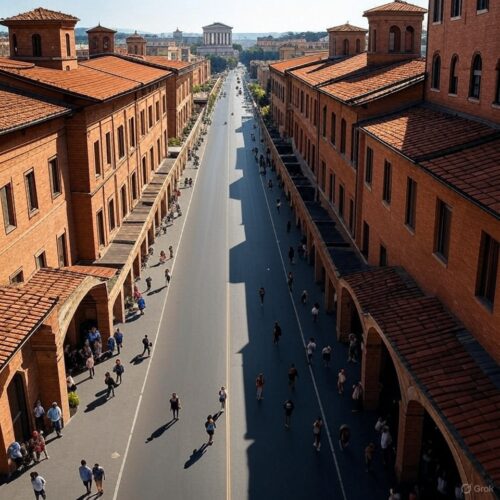
### Lessons from the Ashes: How the Great Fire Ignites Your Life Today
Now, let’s bring this ancient blaze into your world. The Great Fire of Rome isn’t just a dusty history lesson—it’s a treasure chest of wisdom for navigating your own challenges. Here’s how its lessons can light up your life, with specific, actionable steps to make it real.
#### 1. Resilience: Rise from Your Ruins
The Romans didn’t curl up and cry when their city burned—they rebuilt it better. You can too. Life throws fires your way: a job loss, a breakup, a failed dream. Resilience isn’t ignoring the pain; it’s using it as fuel.
– **Plan:** Next time you hit a setback, write down three ways it could make you stronger (e.g., new skills, tougher mindset, fresh start). Pick one and act on it within 24 hours—say, signing up for a course or drafting a new goal. Speed beats despair.
#### 2. Adaptability: Rewrite the Blueprint
Nero saw a burned city and dreamed up a safer one. Adaptability turns chaos into opportunity. Stuck in a rut? Don’t cling to the old—pivot like Rome did.
– **Plan:** Identify one area of your life needing a shake-up (career, fitness, relationships). Brainstorm three bold changes (e.g., switch industries, try a wild workout, plan a daring date). Test one this week and tweak it as you go.
#### 3. Community: Build with Others
Rome’s citizens didn’t rebuild alone—they leaned on each other. Your strength multiplies with support. Lone wolves survive; packs thrive.
– **Plan:** Reach out to three people this month—friend, mentor, neighbor—and ask for help or offer it. Start small: coffee chats, a favor, a joint project. Watch how teamwork lifts you higher.
#### 4. Learn from the Flames: Prevent Your Next Fire
Rome’s new codes stopped future blazes. Your mistakes aren’t failures—they’re data. Learn, adjust, win.
– **Plan:** After your next slip-up (missed deadline, argument), jot down what went wrong and one fix (e.g., set reminders, pause before snapping). Apply it next time—turn oops into aha.
#### 5. Vision: Dream Bigger Than the Ashes
Nero’s *Domus Aurea* was wild, but it screamed ambition. Your disasters can launch epic comebacks. Think grand, then build it.
– **Plan:** Set one crazy-big goal this year (write a book, run a marathon, launch a side gig). Break it into five steps, starting with one you can do today (outline a chapter, jog a mile, sketch a plan). Let the fire push you forward.
These aren’t fluffy platitudes—they’re Rome’s battle-tested playbook. You’ve got disasters; now make them your *Domus Aurea*. The fire didn’t end Rome—it forged it. Let it forge you.
—
### Conclusion: Your Legacy Starts Now
The Great Fire of Rome, born on July 18, 64 AD, was a monster that devoured a city—and birthed a legend. From its six-day rampage to Nero’s audacious rebuild, it’s a saga of ruin and redemption. The historical details—the Circus’s spark, the hills ablaze, the stone streets rising—paint a vivid picture of a Rome that refused to die. But its real gift? The lessons: resilience, adaptability, community, learning, vision. Take them, run with them, and turn your own fires into triumphs. Rome’s still here, 2,000 years later, a testament to what’s possible. What will your legacy be? Start building today—the flames are waiting.
